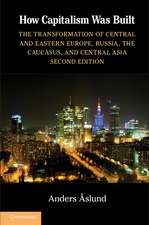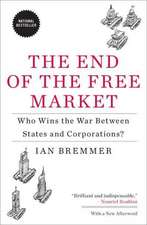European Economic Integration as a Challenge to Industry and Government: Contemporary and Historical Perspectives on International Economic Dynamics
Editat de Richard Tilly, Paul J.J. Welfensen Limba Engleză Paperback – 7 dec 2011
Preț: 653.79 lei
Preț vechi: 769.17 lei
-15% Nou
Puncte Express: 981
Preț estimativ în valută:
125.10€ • 130.95$ • 104.13£
125.10€ • 130.95$ • 104.13£
Carte tipărită la comandă
Livrare economică 31 martie-14 aprilie
Preluare comenzi: 021 569.72.76
Specificații
ISBN-13: 9783642800160
ISBN-10: 3642800165
Pagini: 572
Ilustrații: X, 558 p.
Dimensiuni: 155 x 235 x 30 mm
Greutate: 0.79 kg
Ediția:Softcover reprint of the original 1st ed. 1996
Editura: Springer Berlin, Heidelberg
Colecția Springer
Locul publicării:Berlin, Heidelberg, Germany
ISBN-10: 3642800165
Pagini: 572
Ilustrații: X, 558 p.
Dimensiuni: 155 x 235 x 30 mm
Greutate: 0.79 kg
Ediția:Softcover reprint of the original 1st ed. 1996
Editura: Springer Berlin, Heidelberg
Colecția Springer
Locul publicării:Berlin, Heidelberg, Germany
Public țintă
ResearchDescriere
explicit presentation of some of those stylized facts in the form of a brief, chronologically structured narrative. In keeping with the broad scope of this volume we begin by going back at least two hundred years, to the growth of an integrated national capital market in England in the 18th century (see Neal Chapter). This starting point has the advantage of calling attention to a number of important points. First, the form of integration by which a central market (London) for a standardized good (government bonds or consols) came to serve as linkage between two or more hitherto separate (regional) markets, represents a typical and important form of fInancial (and economic) integration. In Kindleberger's terminology it is the "integration via third parties" form (where, say, security prices in A and B converge): 2 A < -----------> C < ----------------> B instead of A < ------------> B. In the 18th-century English context this central market provided a widely available index of the opportunity costs of alternative investments, the importance of which should not be underestimated, for it contributed to national economic integration in England (NEAL, 1994). Second, this example illustrates an important point of political economy. The prerequisite for the development of the central market mentioned was the establishment of sound public fInances based on the state's widely accepted power to tax.
Cuprins
Contents: European Economic Integration: Did it Matter in the Past, Will it Matter in the Future?- European Economic Integration: Employment, Unemployment and Migration.- The EU Facing Economic Opening-Up in Eastern Europe: Problems, Issues and Policy Options.- Protectionism in Europe before 1939.- Structural Adjustment and Growth Policies in Europe: Competition and/or Cooperation?- International Capital Flows and Political Transition in Europe: Historical Perspectives.- Germany's Changing Competitive Position in World Markets: Required Policy Shifts.- Financial Regulation and the Bank's Role in European Economies.- Sterling in Decline Again: The 1931 and 1992 Crises Compared.- Banks and Industry: Lessons From History?- Banks and Industry in Anglo-German Perspective.- Russia and Europe: Lessons from the Pre-Command Era.- External Liberalization in a Large Country: The Contribution to the Transition Process in Russia.













